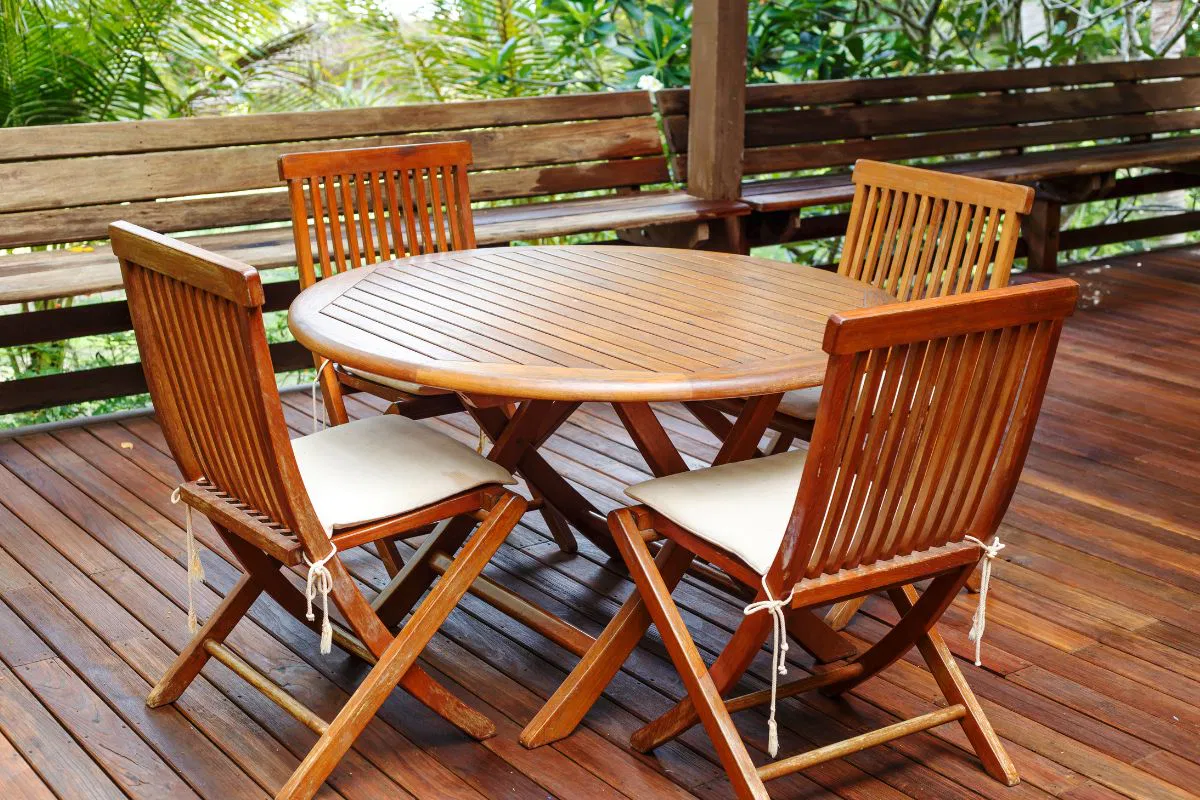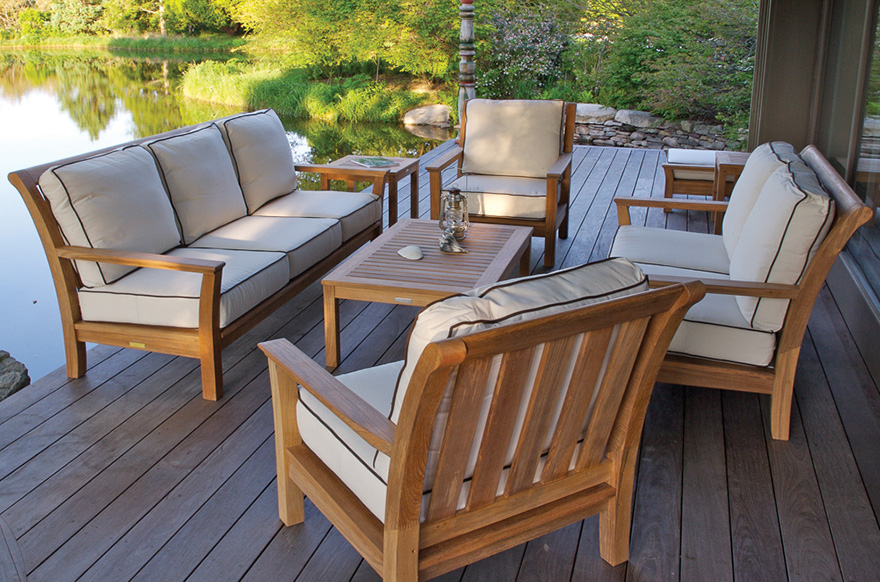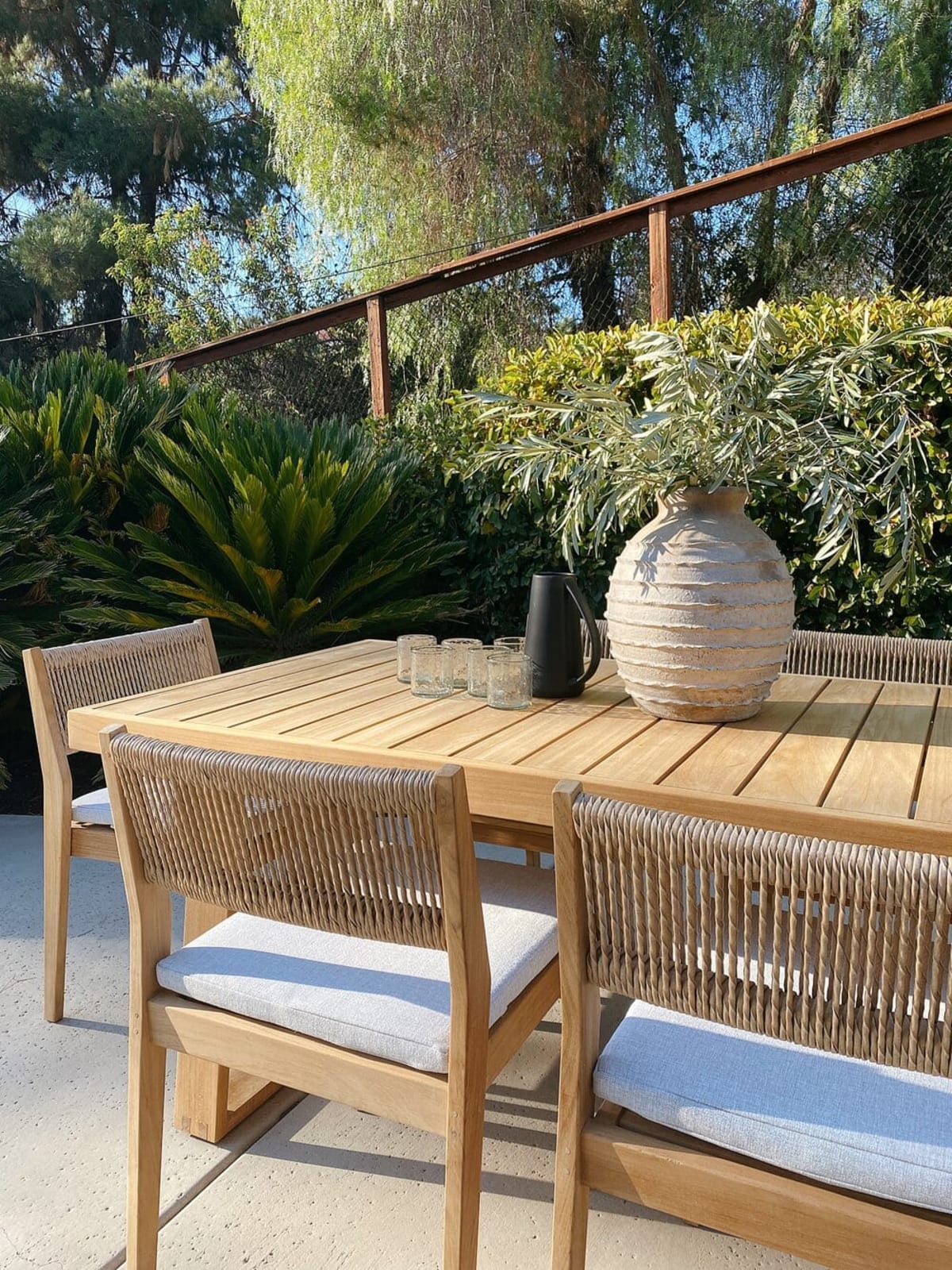Introduction
Outdoor teak furniture adds elegance and functionality to any outdoor space, whether it’s a sprawling garden, cozy patio, or urban balcony. To maintain its beauty and longevity, regular cleaning is essential. In this comprehensive guide, we’ll explore the best practices for cleaning outdoor teak furniture, ensuring it remains a cherished part of your outdoor living environment for years to come.
Understanding Teak Wood
Before diving into cleaning techniques, it’s crucial to understand the characteristics of teak wood. Teak (Tectona grandis) is a dense hardwood prized for its natural durability, resistance to moisture, and high oil content. These properties make it ideal for outdoor furniture, as it can withstand exposure to the elements without warping, cracking, or rotting.

Gathering Supplies
Before you begin cleaning your outdoor teak furniture, gather the necessary supplies. You’ll need a bucket of warm water, mild detergent or teak cleaner, a soft-bristle brush or sponge, and clean cloths or towels for drying. Avoid using harsh chemicals or abrasive cleaners, as they can damage the wood’s surface and finish.
Removing Surface Debris
Start by removing any surface debris, such as leaves, dirt, or cobwebs, from the furniture. Use a soft-bristle brush or a clean cloth to gently brush or wipe away the debris. Pay attention to crevices, corners, and joints where dirt and grime may accumulate.

Preparing the Cleaning Solution
Next, prepare a cleaning solution by mixing mild detergent or teak cleaner with warm water in a bucket. Follow the manufacturer’s instructions for dilution ratios, as they may vary depending on the product. Avoid using bleach or ammonia-based cleaners, as they can damage the wood’s natural oils and finish.
Cleaning the Furniture
Dip a soft-bristle brush or sponge into the cleaning solution and gently scrub the teak furniture, working in the direction of the wood grain. Pay close attention to areas with visible stains or buildup, such as tabletops or armrests. Take care not to scrub too vigorously, as this can scratch the wood’s surface.

Rinsing Thoroughly
After scrubbing the furniture, rinse it thoroughly with clean water to remove any residual cleaner or soap residue. Use a hose or bucket of water to rinse off the cleaning solution, ensuring all surfaces are clean and free of soap suds.
Drying the Furniture
Once the furniture is clean and rinsed, use clean cloths or towels to dry it thoroughly. Wipe down all surfaces, including crevices and joints, to prevent water spots and moisture buildup. If possible, allow the furniture to air dry in the sun for faster drying and to help kill any remaining bacteria or mold spores.

Removing Stubborn Stains
For stubborn stains or discoloration, you may need to use additional cleaning techniques. Create a paste using equal parts baking soda and water and apply it to the stained area. Gently scrub the paste into the wood using a soft-bristle brush or cloth, then rinse thoroughly with water. Alternatively, you can use a commercial teak cleaner specifically designed to remove stains and discoloration.
Maintaining Teak’s Natural Color
Teak wood naturally weathers to a silver-gray patina over time when exposed to the elements. Some homeowners prefer this weathered look, while others want to maintain the wood’s original golden hue. To preserve teak’s natural color, regular cleaning and protective treatments are essential. Additionally, applying a teak brightener or restorer can help revive the wood’s natural beauty by removing surface grime and oxidation.

Applying Teak Sealers and Protectants
While teak is naturally resistant to the elements, applying a sealer or protectant can enhance its longevity and maintain its appearance. Teak sealers form a protective barrier on the wood’s surface, shielding it from moisture, UV rays, and environmental damage. Before applying any sealer, ensure the furniture is clean and dry. Use a brush or cloth to evenly apply the sealer, following the manufacturer’s instructions carefully. Allow the sealer to dry completely before using the furniture. Reapply the sealer annually or as needed to maintain optimal protection.
Addressing Mold and Mildew
In humid or damp climates, outdoor teak furniture may be prone to mold and mildew growth, which can detract from its appearance and compromise its integrity. To prevent mold and mildew, ensure proper ventilation around the furniture and avoid placing it in shaded, moist areas. Additionally, regularly clean the furniture to remove any organic matter or debris that could foster mold growth. If mold or mildew does appear, treat the affected areas promptly with a solution of equal parts water and white vinegar or a commercial mildew remover. Scrub the affected areas gently, rinse thoroughly, and allow the furniture to dry completely in the sun. This proactive approach to mold and mildew prevention will help preserve the beauty and longevity of your outdoor teak furniture.
Protecting Against Physical Damage
In addition to environmental factors, outdoor teak furniture may be susceptible to physical damage from everyday use and activities. To minimize the risk of scratches, dents, and other damage, use coasters, placemats, and tablecloths to protect the surfaces from abrasive items and spills. Avoid dragging heavy objects across the furniture, as this can leave scratches and gouges in the wood. Regularly inspect the furniture for any signs of wear or damage, and address them promptly to prevent further deterioration. By taking proactive measures to protect against physical damage, you can extend the lifespan of your outdoor teak furniture and keep it looking pristine for years to come.
Maintaining Upholstered Components
If your outdoor teak furniture includes cushions or upholstery, proper care and maintenance are essential to prolong their lifespan and keep them looking their best. Remove cushions and upholstery regularly to allow air circulation and prevent mold and mildew growth. Spot clean cushions as needed using a mild detergent and water, and allow them to air dry completely before placing them back on the furniture. For deeper cleaning, consult the manufacturer’s recommendations or consider professional upholstery cleaning services. Store cushions indoors or in a dry, ventilated area during the off-season to protect them from moisture and UV exposure. By maintaining upholstered components properly, you can ensure they remain comfortable, attractive, and functional for years to come.
Conclusion
Regular cleaning is essential for preserving the beauty and integrity of outdoor teak furniture. By following the steps outlined in this guide, you can keep your teak furniture looking its best year-round. With proper care and maintenance, your outdoor teak furniture will continue to provide comfort, style, and enjoyment for years to come. So roll up your sleeves, gather your supplies, and give your teak furniture the TLC it deserves—it’s sure to reward you with many years of outdoor relaxation and entertainment.